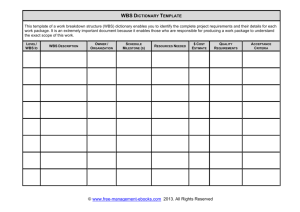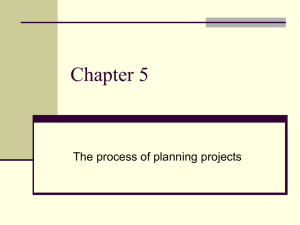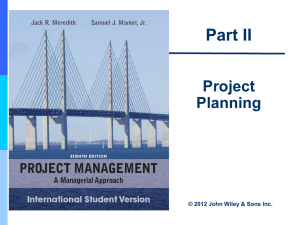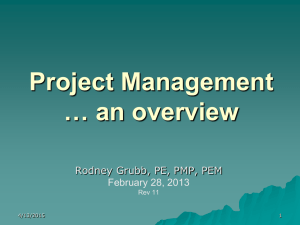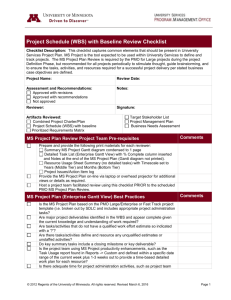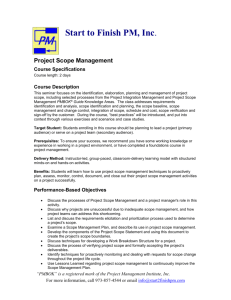AHAB-Lab #2
advertisement
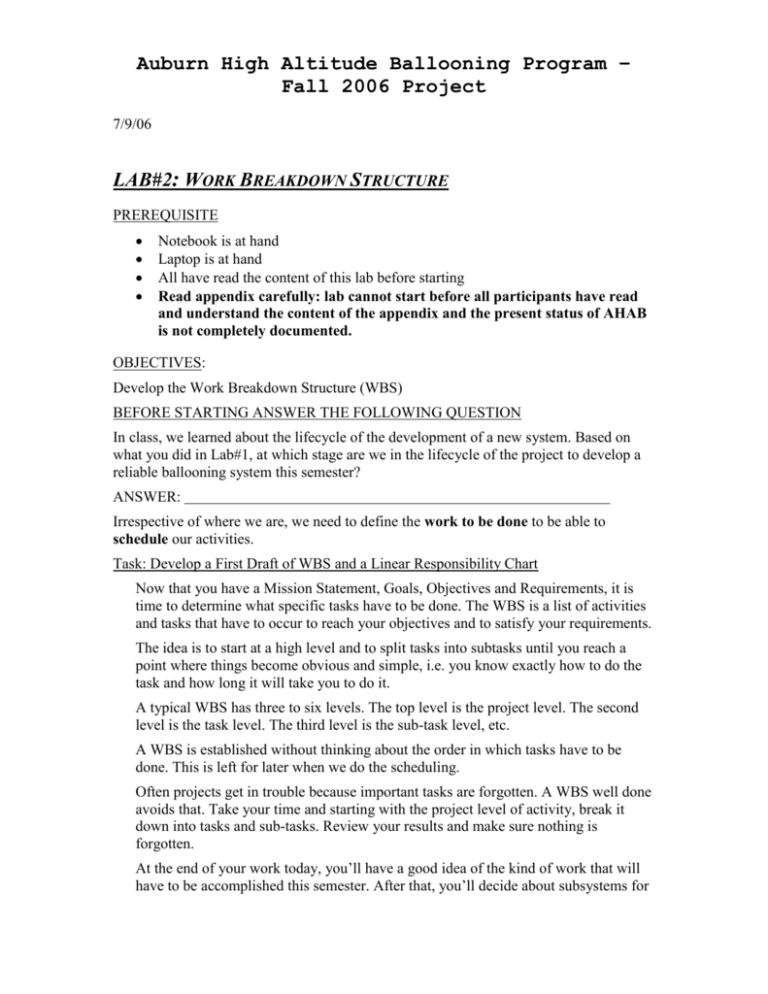
Auburn High Altitude Ballooning Program – Fall 2006 Project 7/9/06 LAB#2: WORK BREAKDOWN STRUCTURE PREREQUISITE Notebook is at hand Laptop is at hand All have read the content of this lab before starting Read appendix carefully: lab cannot start before all participants have read and understand the content of the appendix and the present status of AHAB is not completely documented. OBJECTIVES: Develop the Work Breakdown Structure (WBS) BEFORE STARTING ANSWER THE FOLLOWING QUESTION In class, we learned about the lifecycle of the development of a new system. Based on what you did in Lab#1, at which stage are we in the lifecycle of the project to develop a reliable ballooning system this semester? ANSWER: Irrespective of where we are, we need to define the work to be done to be able to schedule our activities. Task: Develop a First Draft of WBS and a Linear Responsibility Chart Now that you have a Mission Statement, Goals, Objectives and Requirements, it is time to determine what specific tasks have to be done. The WBS is a list of activities and tasks that have to occur to reach your objectives and to satisfy your requirements. The idea is to start at a high level and to split tasks into subtasks until you reach a point where things become obvious and simple, i.e. you know exactly how to do the task and how long it will take you to do it. A typical WBS has three to six levels. The top level is the project level. The second level is the task level. The third level is the sub-task level, etc. A WBS is established without thinking about the order in which tasks have to be done. This is left for later when we do the scheduling. Often projects get in trouble because important tasks are forgotten. A WBS well done avoids that. Take your time and starting with the project level of activity, break it down into tasks and sub-tasks. Review your results and make sure nothing is forgotten. At the end of your work today, you’ll have a good idea of the kind of work that will have to be accomplished this semester. After that, you’ll decide about subsystems for Auburn High Altitude Ballooning Program – Fall 2006 Project AHAB this semester and each one of you will select a primary subsystem in which to participate and a secondary subsystem. You’ll then go back to the WBS and assign responsibility for each task to one participant. Responsibility is always for a student who has primary responsibility for the subsystem the task is for. It is important to work this out carefully and at length to make sure all tasks are included and nothing is forgotten. In order for each group member to have a clear list of responsibilities, each one of you will fill a Personal Responsibility Chart, sign it, and get the signatures of the Student Manager and the AUSSP Director. Example of a WBS for Yard Work: WBS for Yard Project The chart below was obtained from “Fundamentals of Project Management”, Second Edition by James Lewis. The project is to maintain the yard of a private home. The activities are: cleaning up, cutting grass, and trimming. The WBS shows three levels at most, as this is a simple project. Note that trimming the hedge has only one level, whereas the other activities involve two levels. WBS to fo yard pr oject Yard Proj ect C leanup Pick-up Trash 15 mi n Bag g rass 30 mi n H edge cli pping s 15 mi n H aul to dump 45 mi n C ut Grass Mow front 45 mi n Mow back 30 mi n Tri mwork Weeds @ trees 30 mi n Edg e si dewal k 15 mi n Prepare Equi pment Put g as i n eq uipment 5 mi n Get hedge cli pper 5 mi n Tri m Hedg e 30 mi n There is no unique way to build your WBS. One way to organize your WBS could be sequential. You could divide the project into its phases first: design, build, test, launch, analyze data and document. Then divide design into subsystems and subsystems into components. There may be other ways to build the WBS using subsystems as your level one. You may need to go to four levels of tasks here or even five. You will probably end up with four or Auburn High Altitude Ballooning Program – Fall 2006 Project more levels, and you will have to use a table as a chart is very difficult to handle at this level. In this lab you need to proceed to at least three levels. Auburn High Altitude Ballooning Program – Fall 2006 Project WORK BREAKDOWN STRUCTURE Auburn High Altitude Ballooning WBS NUMBER TASK AHAB-7 IN CHARGE Auburn High Altitude Ballooning Program – Fall 2006 Project Auburn High Altitude Ballooning Program – Fall 2006 Project LIST OF SUBSYSTEMS FOR AHAB SUBSYSTEM NAME RESPONSIBILITIES STUDENTS PRIMARY STUDENTS SECONDARY Auburn High Altitude Ballooning Program – Fall 2006 Project Individual Responsibility Matrix Student Name Major/Level Date: Student Signature: Student Manager Signature: Program Director’s Signature: Primary Responsibility Tasks to be Completed during Fall 2006 Semester Auburn High Altitude Ballooning Program – Fall 2006 Project APPENDIX: AHAB Fall 06 Project Constraints AHAB Fall 06 Project has the following constraints. Elements of system that have been built previously: There is a tracking box and an outreach box with data loggers There are two GPS units in the tracking box There are two TNC units in the tracking box There is a power subsystem with batteries: check status There are two antennae There is a rigging subsystem All these elements require a status check, an estimate of readiness and of time interval necessary for fixing and/or testing them. This was to be done in Lab #1. If it is not complete, please do so before the lab starts! This lab is not to start before this is complete. The normal sequential list of activities are: Design build test subsystems integrate test the whole system (lab tests, mooring, test launch) launch operate recover analyze data document. Time constraints (weather permitting): Mooring: 30 September Test Launch: 14 October Outreach Launch: 4 November

